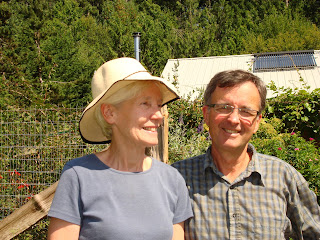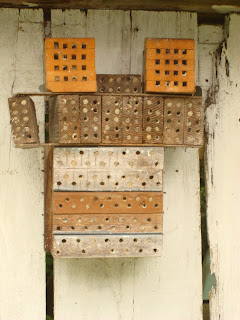Bill Herring gave two talks on Growing Winter Veggies at The Sunflower Cafe in Duncan, BC. Bill has been growing vegetables and fruit on his property in Cobble Hill since 1989. He had his first garden when he was age 7 and he is still growing food 67 years later.
Bill says, "Winter gardening takes a long time, even 12 months for some crops, so be selective if garden space is a consideration."
Bill grows 38 different vegetable crops throughout the year, here are a few of his favorite Winter Crops.
Parsnip:
When you see the greens starting to grow on last years parsnip crop, it's time to plant for next year. The seeds need stratification for good germination and by planting parsnips in Feb/March that can happen. Plant large seeds staggered for ease and less thinning. Collecting seeds is not recommended by Bill because of a severe irritant in the flower head. Bill's favourite variety is a hybrid called 'gladiator' and it's canker resistant.
Potatoes:
Potatoes also get planted early for an early harvest, therefore Bill plants his potatoes in Feb/March too. The frost will set the tops back, but not damage the potato. Start by digging a 8"
trench and line with compost, add potatoes and cover 4" - 5" with soil.
When tops emerge, cover with soil again.
Cover the tops completely 2 – 3 times eventually creating a mound.
In this climate it is best to use the whole potato and in Jan/Feb move your stock potatoes to light to allow “chitting” to occur.
This is when the eyes of the potato form.
Cabbage/Kale/Cauliflower/Broccoli/Brussel Sprouts:
For winter cabbage, cauliflower and purple sprouting broccoli, plant seeds in early July and plant into the garden in August/Sept.
There are varieties specific for winter crops so be sure to buy the correct seed.
In Bill’s garden he has club root which affects the brassica family by creating a nasty root system eventually killing the plant.
Bill has found some club root resistant varieties that he has had good luck with.
The seed is more expensive, but well worth it.
The varieties are called, “Kilton, Crisp and Clapton.
Kale is easy to grow and can be direct seeded in summer for a winter harvest.
Two of Bill’s favorite varieties include ‘Thousand Headed’ and ‘Hungry Gap.’
Brussel Sprouts seeds need to be started in March and take almost a year to produce.
They like to be planted into firm ground and will form rosettes instead of round sprouts if the soil is too soft.
Stake plants to reduce winter damage.
Leeks:
There are two types of Leeks.
One is grown and harvested before Christmas and the other is grown for winter harvest.
Bill sows leek seeds three times a year.
He starts in early Feb. inside using pots covered with plastic bags to create mini green houses.
He pricks them out into cell packs and puts them in the unheated greenhouse to grow on until planting in the garden in May.
Leeks produce a long root system that makes it near impossible to separate later on.
The second batch is started end of April in pots and then he direct seeds into the garden in May.
When planting leeks into the garden, use a crow bar and make a 6” – 8” hole and drop leek into it.
Water and allow the soil to fall into the hole on it’s own.
The leek will eventually fill in the hole and blanch the leek leaving lots of white leek to use.
Bill’s favorite variety is ‘Jolant’
Lettuces:
Bill has been collecting and using the same lettuce seed for over 60 years, it’s called, ‘Little Gem.’
Lettuce is sown every three weeks to guarantee a continual harvest.
In the winter, Bill uses the large clear plastic juice jugs Cranberry juice comes in.
Remove the lid and cut off the bottom to use as cloches over the lettuce to protect from weather.
‘Winter Marvel is a good variety to use for winter.
Swedes/ Rutabagas:
Swedes or Rutabagas are planted in July and harvested in Oct/Nov and later.
Plant seed in a double row in a zig-zag pattern to eliminate thinning.
To eat Swedes, peel, slice, steam or boil until soft, mash add cream and pepper.
Spinach:
Bill tends to plant ‘Perpetual Spinach’ instead of regular spinach because it doesn’t bolt like other spinach.
Perpetual spinach is easy to grow, direct seed in spring and it will lasts all winter, may need thinning to 6” apart
Swiss Chard:
Swiss Chard is another easy green to grow, simply direct seed into garden in spring and it will produce all winter, setting seed in spring.
Bill's knowledge of the vegetable growing world is vast. Be sure to look for Bill's next article on "The 6 Easiest Vegetables to Grow" Thanks Bill for giving us this talk


























